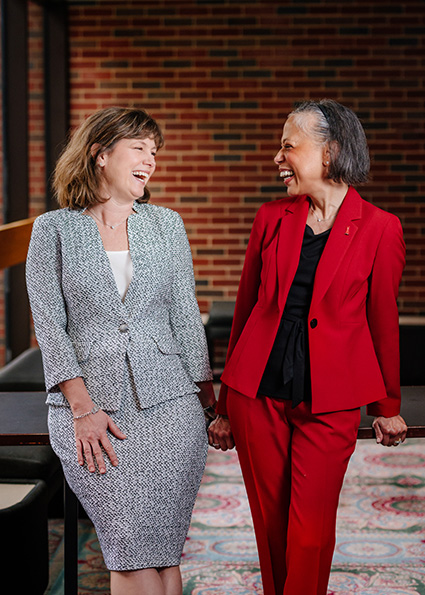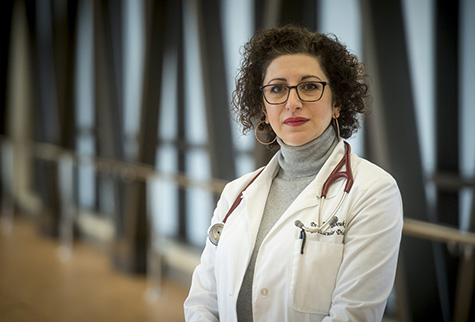Media contact: Adam Pope
 Joy O’Neal and Sherron SimmonsAsk the average person about the leading cause of death for men, and “heart disease” likely will be the response. Ask about the leading cause of death for women, though, and chances are they will come up empty.
Joy O’Neal and Sherron SimmonsAsk the average person about the leading cause of death for men, and “heart disease” likely will be the response. Ask about the leading cause of death for women, though, and chances are they will come up empty.
The correct answer? Heart disease.
According to the Centers for Disease Control and Prevention, heart disease is responsible for one in four deaths among both men and women. And the highest concentration of heart disease deaths for women is in the South — especially in Alabama, Mississippi and Louisiana.
This lack of awareness about women’s heart disease led Salpy Pamboukian, M.D., to establish the UAB Women’s Heart Health Clinic in 2016.
“We don’t think about heart disease in women,” said Pamboukian, a transplant cardiologist and director of the clinic. “As women get older and past menopause, their rates of heart disease are the same as men’s.”
While the classic signs of heart attack in males — chest pain radiating into the jaw and arm — are well-known, a woman’s symptoms may differ dramatically.
“Women may or may not have classic chest pain,” Pamboukian said. “The pain could be in other areas and not necessarily in the center of the chest.”
She notes that pain might not flare up with exertion, as is often the case with men. In fact, sometimes there is no pain at all.
“The symptoms can be shortness of breath, nausea or vomiting, tiredness or fatigue, or abdominal discomfort,” she said.
Ignorance about the prevalence and symptoms of women’s heart disease can, unfortunately, extend to the medical community.
“Women presenting with atypical heart disease symptoms are often written off as having stomach problems or hormone problems,” she said. “Clinical studies have demonstrated inherent biases in how the medical establishment evaluates women differently than men.”
As a result, there can be a significant lag between the time a woman begins experiencing symptoms of heart disease and the time she receives a diagnosis and treatment.
Witnessing those delays prompted Pamboukian to create the UAB Women’s Heart Health Clinic.
“As a cardiologist, I’d see women who had lost precious treatment time,” she said. “We needed a place where women could come, be listened to and be evaluated without biases.”
UAB Women’s Heart Health Clinic
Today, women travel a variety of paths to the UAB Women’s Heart Health Clinic. Some have ongoing symptoms that eventually lead a physician to order an electrocardiogram (EKG) or chest X-ray, resulting in a diagnosis of heart disease and a referral to the clinic. In other cases, women arrive at the doctor’s office or emergency department with heart disease symptoms, are diagnosed quickly and are sent on to the clinic.
Joy O’Neal, 50, eventually found the Women’s Heart Health Clinic, but only after being told by doctors that her weight gain, fatigue and difficulty breathing were due to menopause, stress and allergies — when she in fact had congestive heart failure.
“Even though I presented every symptom of heart disease, they never, ever, ever offered me an EKG,” said O’Neal, founder and executive director of The Red Barn, a therapeutic equine center in Leeds, Alabama. “Dr. Pamboukian said I’d been exhibiting signs of heart disease for two years and that she was going to treat this aggressively. I love the fact that she listened to me and saw me and didn’t assume that these were my first symptoms.”
Once a woman’s heart disease has been identified, the next step depends upon her diagnosis.
“There’s a spectrum of heart disease,” Pamboukian said. “For some, treatment can be as simple as taking medication, while others may need heart transplants.”
In between are those who require arteriograms, stents, valve replacements or bypasses. Pamboukian’s goal is to provide a central place for women to be seen and then refer them to appropriate specialists.
“For example, we have a renowned hypertension specialist and a clinic for people who have difficult-to-manage high blood pressure,” she said.
Although Sherron Simmons’ story has a happy ending, her journey through heart disease was a rollercoaster. Following two heart attacks and bypass surgery, Simmons, now 62, was diagnosed with heart failure and then referred to UAB’s transplant team. Simmons received her heart transplant in 2011 and says she is feeling great today.
“I’m staying in compliance with everything that Dr. Pamboukian and my wonderful transplant nurse tell me to do, and I haven’t had any rejection episodes with my transplant,” Simmons said.
 Salpy Pamboukian, M.DSpreading the Word
Salpy Pamboukian, M.DSpreading the Word
Pamboukian notes that Simmons’ and O’Neal’s health care hurdles are the norm and that one of the best ways to promote healing is education.
“A lot of women aren’t assertive with physicians when their symptoms don’t get better, and they don’t ask for a cardiac evaluation,” Pamboukian said. “That motivated me to get involved with patient advocacy.”
Pamboukian’s commitment to empowering female patients led UAB Medicine to partner with WomenHeart: The National Coalition for Women with Heart Disease, an organization dedicated to heart disease education and patient support. She nominated Simmons and O’Neal to become UAB WomenHeart Champions and secured coalition funding to send the two women to the Mayo Clinic to receive training in heart health advocacy.
Simmons, who is retired and living in Hoover, said attending the four-day WomenHeart Science and Leadership Symposium in Rochester, Minnesota, was “exhausting, wonderful and informative.” Nearly 50 women ages 26 to 74 and from 18 states participated. The attendees, all of whom had heart disease, learned about a variety of topics that ranged from heart disease risk factors and healthy lifestyle choices to mental health and stress reduction.
“I have never been in the presence of that many women who were heart disease survivors,” Simmons said. “It was powerful to know that we’re not alone, that we’re not only survivors but also thrivers.”
O’Neal echoed Simmons’ sentiments, adding that the information she gathered was eye-opening.
“Women’s and men’s bodies are so different when it comes to heart health, but most of the medical research includes men and not women,” she said. “I had thought my odds of dying from breast cancer were higher than dying from heart disease, but it’s the opposite. I couldn’t believe that this information is generally unknown to women.”
Paying It Forward
As UAB WomenHeart Champions, Simmons and O’Neal are helping educate women in the Birmingham area about heart health. Pamboukian believes the two volunteers are uniquely qualified to spread the word.
“Women can connect with Sherron and Joy on a personal level and understand that the same thing could happen to them, rather than learning information from health care providers who haven’t lived though the experience of heart disease,” she said.
Pamboukian has high expectations for UAB’s WomenHeart program.
“We want to educate as many women as we can in as many different venues as we can,” she said. “Rather than just bringing women into the hospital, we want Sherron and Joy to connect with them in community groups, houses of worship and workplaces.”
Armed with WomenHeart PowerPoint presentations, lectures and handouts, Simmons and O’Neal plan to launch UAB’s heart health initiative in February.
“We’ll have a two-pronged approach,” O’Neal said. “I’ll coordinate the educational piece for places such as community fairs, women’s lunch groups and Bible study groups, and Sherron will organize a peer-led monthly WomenHeart support group at UAB.”
Simmons is excited about the prospect of helping women with heart disease to find one another.
“I had a strong family support system, but there was not another woman I could really talk to about having heart disease,” she said. “Women need to know they’re not alone in this fight.”
She plans to rely on the UAB community to speak at monthly meetings.
“We hope to have a nutritionist speak about heart health diets, a mental health professional speak about mental health and heart disease, a cardiac rehabilitation nurse, a certified fitness trainer, and possibly even a yoga instructor to help women improve their health and their quality of life,” she said.
Simmons’ bottom line?
“Heart disease does not define who you are,” Simmons said. “You can go on and live a full life.”
Simmons says the opportunity to help other women through sharing her story is something she had prayed about.
“UAB has given us a wonderful platform,” she said. “As women, we’re caregivers; but I want to talk about the importance of taking care of ourselves.”
Importance of Education
O’Neal has doubled down on educating women about heart disease, in part because — even after her diagnosis — she still fights ignorance within the medical community. A dermatologist told her she was too young to have heart disease and questioned whether she had in fact had a heart attack. “Two doctors told me I must have misunderstood my diagnosis because I was too young and looked healthy,” O’Neal said. “Knowing what I know now, I want to educate women so they can argue back with confidence.”
Before her diagnosis, every time O’Neal saw her primary care physician, he asked whether she had had a mammogram. “I have no family history of breast cancer or cervical cancer, and I’m routinely screened for those,” she said. “But I’m not screened for the one thing I’m statistically most likely to die from.”
While stressing the importance of mammograms and Pap tests, O’Neal said, “Women’s heart health should be discussed as much as breast cancer.” She believes that a baseline EKG would have led to a quicker diagnosis and faster treatment. Pamboukian expressed a similar sentiment, adding, “Heart disease can affect any woman, and we need to increase awareness about screening.”
Both O’Neal and Simmons say they are grateful for the UAB Women’s Heart Health Clinic. “They saved my life, and they are doing so much to help women in the Birmingham community,” O’Neal said. “I am blessed to live near a world-renowned research center that allows women to get the heart health treatment they need.”